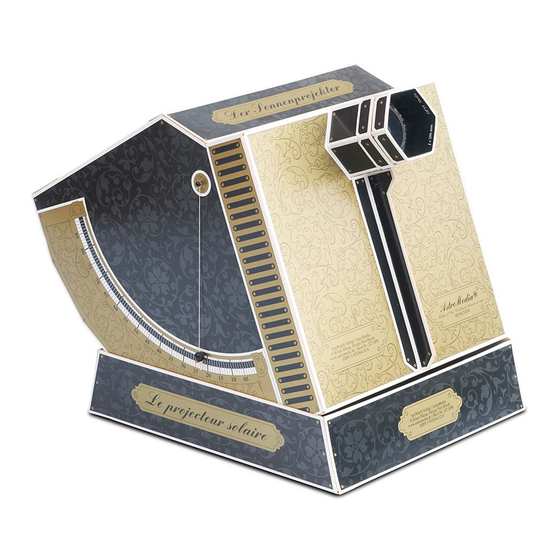AstroMedia 227.SPR Руководство - Страница 6
Просмотреть онлайн или скачать pdf Руководство для Проектор AstroMedia 227.SPR. AstroMedia 227.SPR 6 страниц. Cardboard kit for a projector that allows for safe observation of the sun

keinen Sonnenfilter? Der direkte Blick auf die
Sonne, ob mit oder Teleskop, erfordert immer
einen Sonnenfilter. Beim Sonnen-Projektor fällt
der Blick aber nicht auf die Sonne, sondern
nur ihr Abbild. Das projizierte Sonnenbild ist
7. How can I tell if what Iʼm seeing is a sun spot or a piece of dust in the optical system? Move the Solar Projector a bit
nicht gefährlicher als ein Stück sonnen-
forwards and backwards so that the solar image moves around the projection surface. If the spot moves as well, it belongs to the
beschienenes Papier.
Sun. If it doesnʼt, it is probably on the plane mirror. Dirt on the lenses donʼt cause spots, they just make the image poorer.
2. Was kann ich alles mit dem Sonnen-Pro-
8. What are the grids below for? The grids correspond to the sizes of the two solar images. You can put them on the projection
jektor beobachten? Vor allem Sonnenflecken,
surface to record the exact position of sun spots and thus by making observations over a period of time, see how they have
aber auch Sonnenfinsternisse und Planeten-
changed.
transits. Sogar Landschaftsbeobachtungen
9. How can I determine the height of the Sun? The height of the Sun is the angle between it and the horizon. It can be read
sind unter günstigen Umständen möglich.
directly from the two quadrants. The Solar Projector must, of course, be placed on a flat horizontal surface. You can check this
3. Sind auf der Sonne immer Sonnenflecken
with a spirit level (for example the mini-spirit level from AstroMedia, order number 410.WAS) or by rotating the Solar Projector by
zu sehen? Die Zahl der Sonnenflecken
180°. If you get the same angle again, the surface must be horizontal.
schwankt in einem Rhythmus von etwa 11 Jah-
10.What happens if I hold a coloured filter in front of the objective? Try it! The contrast of the image changes with the chosen
ren. Das letzte Minimum war 1995, das nächste
filter. You can try similar experiments with coloured paper on the projection surface.
11.What are the hexagonal apertures for? You can put these behind the large aperture in the objective and therefore reduce the
aperture opening. Smaller apertures make the image sharper, but dimmer. But that could be desirable, for example if you find the
solar image too bright. It can sometimes be easier to make out sun spots in a dimmer image.
with the fascinating and fully operational cardboard kits by AstroMedia
The Stardial
Visit our website
AstroMedia UK ✵ Landell ✵ Brick Kiln Lane ✵ Ingham, Norwich ✵ NR12 9SX ✵ Phone: 07864 912372
20. März 2015). Eine totale Sonnenfinsternis
wird erst wieder 2081 in Deutschland zu se-
hen sein.
6. Was ist ein Planetentransit? Die Bahnen
von Merkur und Venus um die Sonne liegen
innerhalb der Bahn der Bahn Erde. Es kann
deshalb vorkommen, dass von der Erde aus
gesehen Merkur oder Venus so exakt vor der
Sonne stehen, dass sie für eine kurze Zeit vor
der Sonnenscheibe vorbeiziehen. Ein solcher
Planetentransit (oder Planetendurchgang) ist
aber ein sehr seltenes Ereignis, weil die Bah-
nen der Planeten nicht genau in der selben
Ebene liegen. Am 8. Juni 2004 wird ein
Venustransit in Deutschland zu sehen sein,
zum ersten Mal seit Dezember 1882.
Wissenschaft begre
Understand Science
Das Kopernikus-Planetarium
The Orrery
and many, many more .....
www.AstroMediaShop.co.uk
Das Pseudoskop
mit den faszinierenden, voll funktionstüchtigen
Bausätzen von AstroMedia
for more kits, optical components, and interesting gadgets.
ist die Fläche horizontal.
10. Was passiert, wenn ich einen Farbfilter
vor das Objektiv halte? Probieren Sie es aus!
Je nach gewähltem Filter verändert sich der
Kontrast des Bildes. Ähnliche Experimente
können Sie auch mit farbigem Papier auf der
Projektionsfläche machen.
11. Wozu dienen die sechseckigen Blen-
den? Man kann sie hinter die große Blende im
Objektiv setzen und damit die Blendenöffnung
verringern. Kleinere Blenden machen das Bild
schärfer, zugleich aber auch dunkler. Genau
das kann aber auch gewollt sein, z. B. wenn
das Sonnenbild als zu hell empfunden wird. In
einem abgedunkelten Bild können Sonnenfle-
cken manchmal besser erkannt werden.
Die Dampfmaschine
The Newton Telescope
Der Sextant
Das Newton-
Der Stirl
